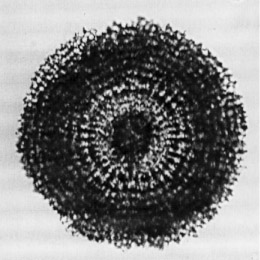 Lithocyclia
ocellus Ehrenberg group
Lithocyclia
ocellus Ehrenberg group Lithocyclia
ocellus Ehrenberg group
Lithocyclia
ocellus Ehrenberg groupLithocyclia ocellus Ehrenberg, 1854, pl.36, figs.30; 1873, p.240
Lithocyclia ocellus Ehrenberg, Riedel and Sanfilippo, 1970, p.522, pl.5, figs.1-2
Medullary shell double. Phacoid cortical shell with circular to subcircular pores, 12 to 18 µm on a diameter, covered in some specimens by a thin spongy layer. Cortical shell surrounded by a continuous spongy zone, which, in late specimens especially, is usually concentrically zoned, the innermost zone commonly being the widest and most distinct. Spines of variable number (sometimes none), bladed, acute, originate within the spongy zone, or at the periphery of the cortical shell, or occasionally at the outer medullary shell (Riedel and Sanfilippo, 1970).
Diameter of outer medullary shell 35-50 µm, of cortical shell 85-140 µm, of outer spongy zone 165-325 µm (Riedel and Sanfilippo, 1970).
Surrounding the periphery of the phacoid cortical shell is a continuous spongy region that in late specimens is concentrically zoned and in very early specimens extends over the surface of the cortical shell. Marginal spines may or may not be present (Riedel and Sanfilippo, 1978a).
The Lithocyclia aristotelis group differs by the spongy girdle being interrupted to form arms, members of the genus Periphaena lack a spongy girdle, and Stylocyclia dimidiata Ehrenberg (1873, p.257; 1875, pl.29, fig.4) and related forms have two opposite spines that originate at the medullary shell, traverse the wide phacoid shell, and extend beyond the concentrically zoned girdle (Sanfilippo et al., 1985).
The only constant features of members of this species-group are the double medullary shell, phacoid cortical shell, and broad equatorial girdle of spongy material. Cortical shell has subcircular to circular pores, 12-18 on a diameter, and in some specimens is covered by a thin spongy layer. The equatorial flange is concentrically zoned in late specimens, the innermost zone being the widest. Many specimens have a variable number of bladed, acute spines which originate within the spongy zone or at the periphery of the cortical shell (Sanfilippo et al., 1985).
The L. ocellus group is common and widely distributed in sediments from late early Eocene through middle Eocene. Its morphotypic first appearance lies within the Buryella clinata Zone and its evolutionary transition to the Lithocyclia aristotelis group is approximately synchronous with the base of the Podocyrtis goetheana Zone.
The origin of this earliest coccodiscid, which gave rise to the L. ocellus group, remains obscure.